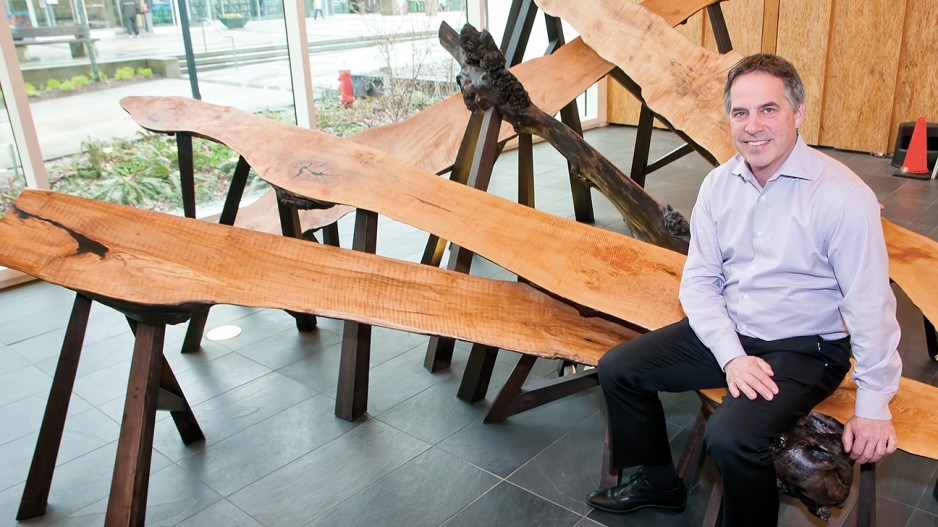Is a transit line from Vancouver’s North Shore to downtown a pipe dream or can enough buzz stir a study into action?
City of North Vancouver Mayor Darrell Mussatto was in the news earlier this year for lobbying TransLink to explore the possibility of an underground rapid transit line from North Vancouver to downtown.
“We need to start having a discussion about what costs would be for alternatives,” Mussatto said, “and, probably even before that, how we see the North Shore fitting into the regional growth.”
In Mussatto’s vision, the line would run underneath Burrard Inlet from North Vancouver’s Lonsdale Quay to Waterfront station, a distance of roughly 3.3 kilometres. The inlet at its deepest point reaches 70 metres.
Estimated costs are tentative, but Mussatto has been quoted anywhere from $1 billion to $5 billion. He’s already spoken with TransLink CEO Kevin Desmond, who has expressed interest in the project.
The discussion comes at a time when commuter rail and high-speed rail are becoming a more attractive option for the West Coast.
With the construction of the new Port Mann Bridge and the increase in visitors to Vancouver, North Vancouver has become an overworked thoroughfare for commuters and travellers heading on to the Sea-to-Sky Highway, the Sunshine Coast and beyond.
“There are more people coming onto the North Shore than there are leaving,” Mussatto said. “People are coming from Seattle, from the States, from Vancouver, all of the Lower Mainland and commuting through the North Shore.”
So why aren’t we looking at more commuter rail?
Underground rapid rail isn’t the only option. Double-tracking the existing rail line that runs underneath the Ironworkers Memorial Bridge has been touted as a possibility, but, according to Mussatto, it wouldn’t work.
“The challenge with [double-tracking] is that [the Second Narrows rail crossing] is a very active bridge, up and down all the time,” said Mussatto. “Users will not stand for breaks; if that bridge has to wait to let a boat go by, that’s 20 to 30 minutes of delay.”
Still, the idea has spurred further conversation about re-establishing commuter lines on existing tracks.
“I’ve been working with Marg Lampman, mayor of Lillooet, to see if we can’t re-establish some passenger rail up the existing corridor,” Mussatto said, “from North Vancouver to Horseshoe Bay to Squamish to Whistler, then up to Pemberton and Lillooet.”
Last year, Whistler’s Pique Newsmagazine reported that real estate development company Matthews Southwest had been building support for a feasibility study for a potential high-speed rail line in the Sea-to-Sky corridor.
“We signed a letter of support saying we think this is an initiative worth exploring,” said Squamish Mayor Patricia Heintzman.
But since submitting her support, Heintzman has not heard any news on the idea. Whistler Mayor Nancy Wilhelm-Morden mirrored Heintzman’s enthusiam.
“In the past, it was determined that the demand wouldn’t be high enough but times have changed,” said Wilhelm-Morden. “Local traffic has grown; high-speed rail could be very important.”
The high-speed rail line project would need roughly 40 kilometres of track, without sharp turns, which means it will likely need tunnels through mountains.
Other plans being discussed envision moving visitors to Vancouver from Washington and Oregon on high-speed rail.
Earlier this year, Washington state Gov. Jay Inslee allocated US$1 million to study the possibility of a high-speed rail line that could connect Vancouver, Seattle and Portland.
In the Lower Mainland, Surrey has been in the market for a new light-rail transit line, yet that project has been in limbo, with estimated costs reaching $2.1 billion.
Despite the high costs and long time scales involved, Mussatto sees rail as the future of travel.
“If we continue to keep building for automobiles it will be a game we will never win. You can’t build enough road space and, ironically, it worsens the quality of your life.”
According to the Canada Transportation Act Review report tabled last year, passenger rail in Canada faces some major challenges.
Lengthy journey times, low frequency of trips, track capacity constraints and increased competition from alternative transportation options are all factors that influence ridership.
Canada’s provincial and federal governments also plan and run rail operations in isolation, compared with regions like Europe and Australia, where there is significant intergovernmental co-operation.
Pipe dream or not, vehicle travel within Metro Vancouver is a headache for everyone, Mussatto said.
“The public needs to hear that there is a cost to having single-occupant vehicles everywhere. Let’s get down to good transportation policy planning; let’s make some good long-term decisions so after we are gone the decisions we’ve made are good ones, not ones the future generation has to fix.”




